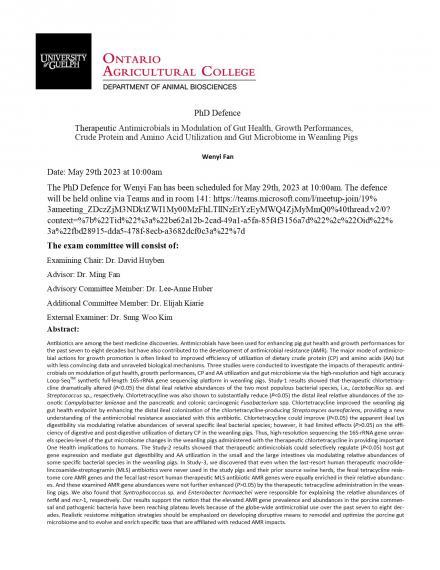Wenyi Fan's PhD Defence
Date and Time
Location
Room 141 and teams: https://teams.microsoft.com/l/meetup-join/19%3ameeting_ZDczZjM3NDktZWI1My00MzFhLTllNzEtYzEyMWQ4ZjMyMmQ0%40thread.v2/0?context=%7b%22Tid%22%3a%22be62a12b-2cad-49a1-a5fa-85f4f3156a7d%22%2c%22Oid%22%3a%22fbd28915-dda5-478f-8ecb-a3682dcf0c3a%22%7d

Details
Therapeutic Antimicrobials in Modulation of Gut Health, Growth Performances, Crude Protein and Amino Acid Utilization and Gut Microbiome in Weanling Pigs
Antibiotics are among the best medicine discoveries. Antimicrobials have been used for enhancing pig gut health and growth performances for the past seven to eight decades but have also contributed to the development of antimicrobial resistance (AMR). The major mode of antimicro-bial actions for growth promotion is often linked to improved efficiency of utilization of dietary crude protein (CP) and amino acids (AA) but with less convincing data and unraveled biological mechanisms. Three studies were conducted to investigate the impacts of therapeutic antimi-crobials on modulation of gut health, growth performances, CP and AA utilization and gut microbiome via the high-resolution and high accuracy Loop-SeqTM synthetic full-length 16S-rRNA gene sequencing platform in weanling pigs. Study-1 results showed that therapeutic chlortetracy-cline dramatically altered (P<0.05) the distal ileal relative abundances of the two most populous bacterial species, i.e., Lactobacillus sp. and Streptococcus sp., respectively. Chlortetracycline was also shown to substantially reduce (P<0.05) the distal ileal relative abundances of the zo-onotic Campylobacter lanienae and the pancreatic and colonic carcinogenic Fusobacterium spp. Chlortetracycline improved the weanling pig gut health endpoint by enhancing the distal ileal colonization of the chlortetracycline-producing Streptomyces aureofaciens, providing a new understanding of the antimicrobial resistance associated with this antibiotic. Chlortetracycline could improve (P<0.05) the apparent ileal Lys digestibility via modulating relative abundances of several specific ileal bacterial species; however, it had limited effects (P>0.05) on the effi-ciency of digestive and post-digestive utilization of dietary CP in the weanling pigs. Thus, high-resolution sequencing the 16S-rRNA gene unrav-els species-level of the gut microbiome changes in the weanling pigs administered with the therapeutic chlortetracycline in providing important One Health implications to humans. The Study-2 results showed that therapeutic antimicrobials could selectively regulate (P<0.05) host gut gene expression and mediate gut digestibility and AA utilization in the small and the large intestines via modulating relative abundances of some specific bacterial species in the weanling pigs. In Study-3, we discovered that even when the last-resort human therapeutic macrolide-lincosamide-streptogramin (MLS) antibiotics were never used in the study pigs and their prior source swine herds, the fecal tetracycline resis-tome core AMR genes and the fecal last-resort human therapeutic MLS antibiotic AMR genes were equally enriched in their relative abundanc-es. And these examined AMR gene abundances were not further enhanced (P>0.05) by the therapeutic tetracycline administration in the wean-ling pigs. We also found that Syntrophococcus sp. and Enterobacter hormaechei were responsible for explaining the relative abundances of tetM and mcr-1, respectively. Our results support the notion that the elevated AMR gene prevalence and abundances in the porcine commen-sal and pathogenic bacteria have been reaching plateau levels because of the globe-wide antimicrobial use over the past seven to eight dec-ades. Realistic resistome mitigation strategies should be emphasized on developing disruptive means to remodel and optimize the porcine gut microbiome and to evolve and enrich specific taxa that are affiliated with reduced AMR impacts.
Date: May 29th 2023 at 10:00am